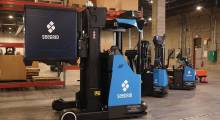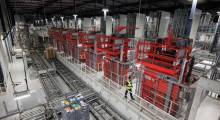Getting the most from a motion system means finding a linear actuator that works efficiently, is durable, and moves a load safely. Smart actuators — robust enough for higher-duty cycle applications and able to provide repeatable motions and feedback capabilities — can do all that and more.
Have you ever heard of a “smart actuator”? A smart actuator is an integrated actuator that includes onboard controls, communication capabilities, position control and feedback, and fault detection. These features make the actuator easy to install, use, program, and monitor while eliminating the need for external controls.
Equipped with integrated hardware and technology beyond that of a standard actuator, a smart actuator is robust enough to handle high-duty-cycle applications while bringing plug-and-play control to industrial material handling applications. Smart actuators also provide fault reporting and performance feedback, unlike a standard actuator, which aids in troubleshooting by detecting and reporting faults such as loss of power, motor overheating, communication errors, and more.
How Can You Benefit from Smart Linear Actuators?
Smart actuators combine intelligent technology with robust machinery to enable easy installation, configuration, and operation so systems can get up and running quickly and perform reliably. By incorporating intelligent capabilities, such as performance feedback or electronic programmable limit switches (EPLS), smart actuators are easier to set up, operate, adjust, troubleshoot, and monitor.
- Improved Control and Feedback: Integrated analog and digital I/O can provide positioning feedback and enable precise position control via a programmable logic controller (PLC). As another operational option, Ethernet/IP connectivity can enable direct connection to a PLC, providing various control options and configurations to choose from when programming motion sequences. While standard actuators provide a minimal level of feedback, a smart actuator’s analog I/O receives a position control signal and provides feedback on the actuator’s position. Digital inputs can extend or retract the actuator, while digital outputs provide indications when limits are reached. Plus, by using configuration software, a smart actuator’s speed and other parameters can be modified to compensate for changes while the actuator is in operation.
- Enhanced Precision Motion: Ethernet/IP communication enables a smart actuator to connect directly to a PLC, providing an infinite number of control options and configurations to choose from when programming complex patterns and motion sequences. Utilizing a VFD combined with an absolute position encoder results in precise motor movements that ensure products are moved safely and efficiently.
- Increased Productivity: When running in high-duty-cycle operations, standard actuator operation oftentimes has to be paused to allow a linear actuator to cool down from the heat generated by the motor. A smart actuator improves duty cycles, extending the time an actuator can operate reliably. This ultimately increases production rates. VFD control also enables automatic soft starting and smooth ramp-up acceleration to prolong an actuator’s operational life. Standard actuators, on the other hand, apply 100% power to the motor at startup, resulting in up to six times the normal running current. Smart actuators soft start the motor and gradually ramp up speed, easing stress on components and prolonging the actuator’s life.
- Simplified Programming: Smart actuators make it easy to program specific parameters based on application needs. For example, EPLS defines specific stopping points, helping to provide greater precision and accuracy and increased ability to repeat motions compared to actuators that use mechanical limit switches. Integrated VFDs and onboard control systems allow operators to program specific motion patterns and adjust actuator speed to the optimal rate to match application needs.
- Quick and Easy Installation and Setup: Optional analog and digital or Ethernet/IP communications allow a smart actuator to directly connect with a PLC or other control or monitoring system without any intermediary components. Other actuator configurations require a separate VFD or contactor control system that is housed in an external control panel.
What Applications Are Ideal for Smart Actuators?
Smart actuators are designed to provide reliable operation, enable precise motion control, and simplify applications, especially those that can benefit from automation technology. For many applications, there is limited space to install large components or panels that will interface with a standard actuator. Smart actuators have small footprints because they feature onboard VFDs and control circuitry. By incorporating VFD control into an actuator, operators also gain the ability to program specific movement patterns with variable speeds, expanding the range of applications a smart actuator can be applied to. Some of these include:
- Providing damper control for exhaust systems: actuators assist with adjusting a damper’s position while also providing feedback on its position
- Material handling, packaging, and sorting: smart actuators can move and divert products inside a plant to prepare them for distribution, storage, etc.
- Balancing loads on automated guided vehicles (AGVs): controllability and feedback capabilities increase the reach of smart actuators for use on AGVs that move around a plant, receiving goods and transporting them to other production stages
- Synchronizing lifting tables: smart actuators synchronize motion to ensure lift tables are at the appropriate height so workers can comfortably complete tasks
- Controlling HVAC systems: smart actuators control, divert, or stop airflow in facilities with mine ventilation systems, dust collection, chemical fumes, and more
Article topics










